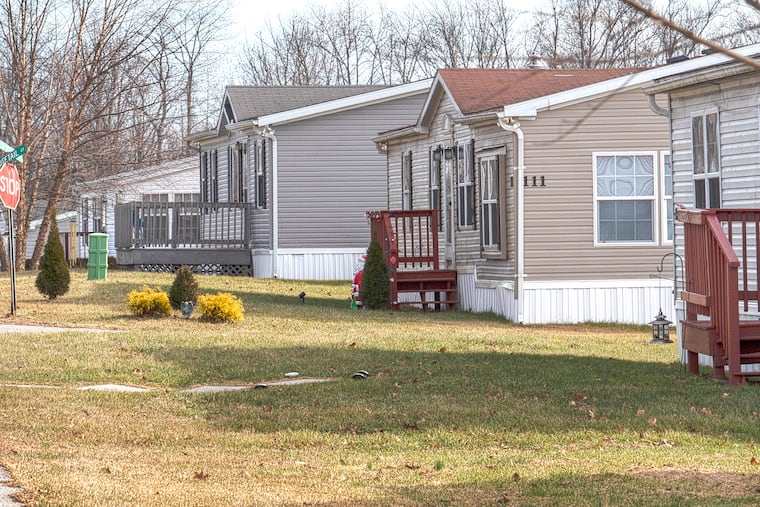Manufactured-home communities aren’t just in rural Pa. Owners on rented land are often unprotected.
About half of mobile homes and other manufactured homes in Pennsylvania are in urban areas, including 129 communities in Philadelphia suburbs.

Mobile homes and similar single-family dwellings that are built elsewhere and placed on rented land have long been a low-cost option for aspiring homeowners across Pennsylvania.
Manufactured-housing communities are disproportionately in rural areas, but they’re not exclusive to small rural pockets. In Pennsylvania, a slight majority are in urban areas, particularly in suburbs outside midsize and large cities, according to the first statewide analysis of these communities, published by the Federal Reserve Bank of Philadelphia.
» READ MORE: Mobile homes are taxed as homes, but they depreciate like vehicles
Trends in lot vacancy suggest that demand for these homes is strongest “on the outskirts of larger urban areas, where they may represent a more attainable option for lower-income home buyers,” according to the report, which looked at the subset of manufactured-housing communities in which homeowners rent land.
These manufactured-home communities, including many just outside Philadelphia, provide unsubsidized affordable housing in areas that have lower poverty rates than the state overall, unlike formal subsidized housing developments, which are more likely to be in economically distressed areas, the analysis found.
Pennsylvania’s 2,288 manufactured-housing communities — home to an estimated 55,900 households — are present in every county except Philadelphia. The city’s collar counties of Bucks, Chester, Delaware, and Montgomery have a total of 129, and more than 20% of these communities have 100 or more homes. One community in Falls Township, Bucks County, has more than 1,000 homes.
But data on manufactured-housing communities are scarce. And Eileen Divringi, community development research specialist at the Philadelphia Fed and the report’s author, called them “a really under-considered affordable housing tool, potentially, for some communities.”
“There is a stigma associated with these communities that’s sort of deeply rooted in the history of these communities and how they emerged that’s sort of a class-based bias that presumes that these communities are transient or something like that,” she said. A “perception that they weren’t worth studying” has been the result of that thinking.
Owners of manufactured homes are vulnerable
“The fact that they are so under-studied has contributed to a lot of gaps in policy protections” for owners of manufactured homes, Divringi said.
And they need protections. Owners in manufactured-home communities who rent land are among the lowest-income homeowners in the country, according to the report released last week. Their incomes are lower than both buyers who purchase homes that were built on site and manufactured-home buyers who own land.
But because of the type of loan these homeowners use, they weren’t able to take advantage of perks in the federal CARES Act that granted more time for struggling homeowners to pay their mortgages during the pandemic, Divringi said.
If homeowners default on loans for manufactured homes, they lose their properties through repossession, which is a faster process than foreclosure and includes fewer recourses for residents. The loans are less regulated and have higher interest rates.
And although modern manufactured homes are similar in quality to homes built on site, owners of older manufactured homes or those not installed properly face expensive repairs. A Philadelphia Fed report published in March found that nationwide, more than 43% of manufactured homes needed repairs — more than the shares of other single-family and multifamily homes.
Manufactured-home owners may not qualify for home repair assistance or homeowner relief programs because of the structure of their land-use agreements.
“It’s really important to draw attention to that,” Divringi said, “and make sure that these homeowners who are disproportionately lower income, disproportionately vulnerable households are not falling through the cracks.”
» READ MORE: The Philly area doesn’t have enough homes available for low- and middle-income buyers
What makes homes in these communities affordable for these households is that owners finance only the factory-built unit and rent the land. Statewide, the typical monthly payment on the type of loan most often used was $376 between 2019 and 2021. The typical lot rent is $370.
“The fundamental affordability of this model can erode pretty quickly,” Divringi said. “And that’s something that renters in all circumstances experience,” but walking away because of rising rent is even more difficult when owners have invested in the home as an asset.
“Mobile home” may be a popular catchall term for these kinds of homes, but they’re not that mobile, Divringi said. Many people are living in homes that are too old or expensive to move. And they may not be able to find another community to place their homes in.
Yet renting land is the more attainable option for many compared to owning it, which is more affordable long-term. Households that rent land trade a lower barrier to entry for a living situation that can be insecure.
Divringi said the lack of research and “policy neglect of these communities” make them insecure, not the manufactured-housing model itself.
For policymakers who want to preserve low-cost home ownership, “there’s a lot of opportunities for policy innovation that will really improve the lives of a lot of vulnerable homeowners,” she said.
The Philadelphia Fed is planning further research about manufactured-housing communities, including their vulnerability to climate-related risks such as flooding and excessive heat, and residents’ access to infrastructure.